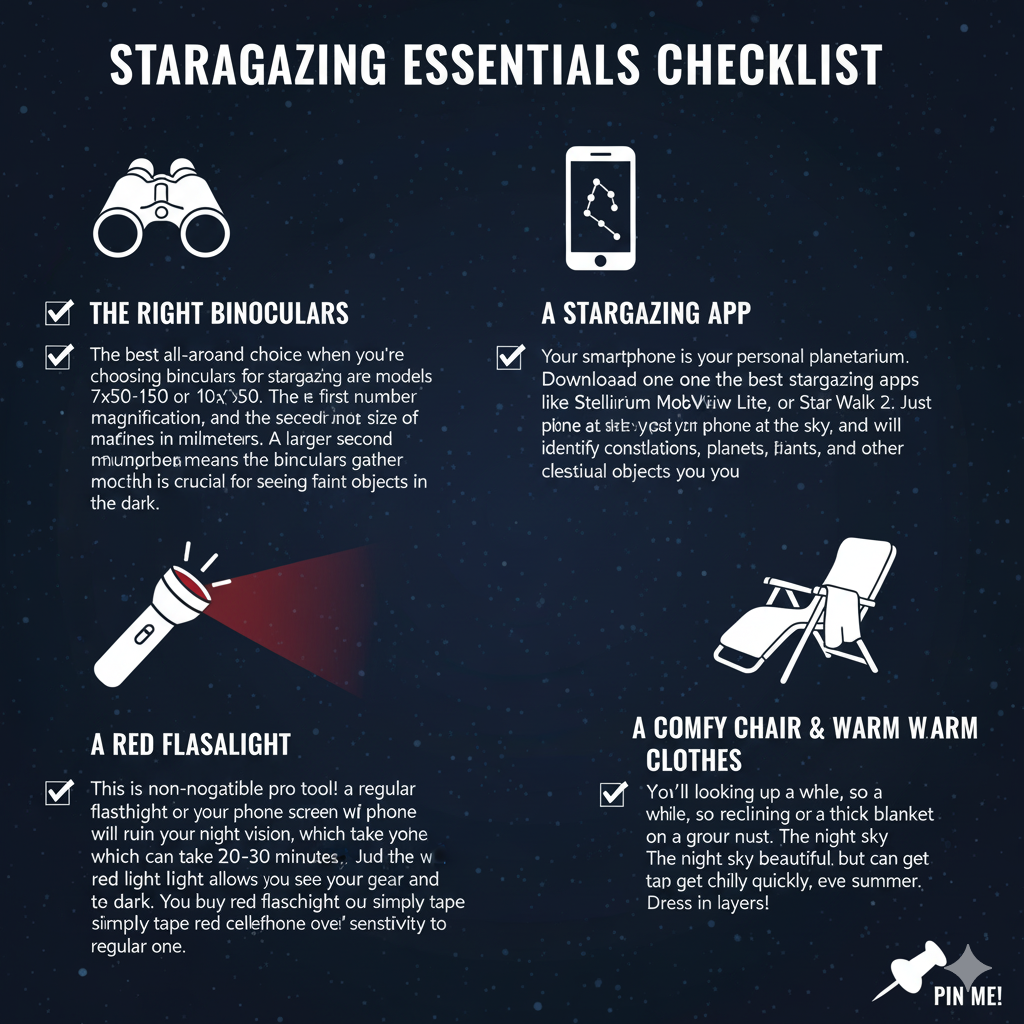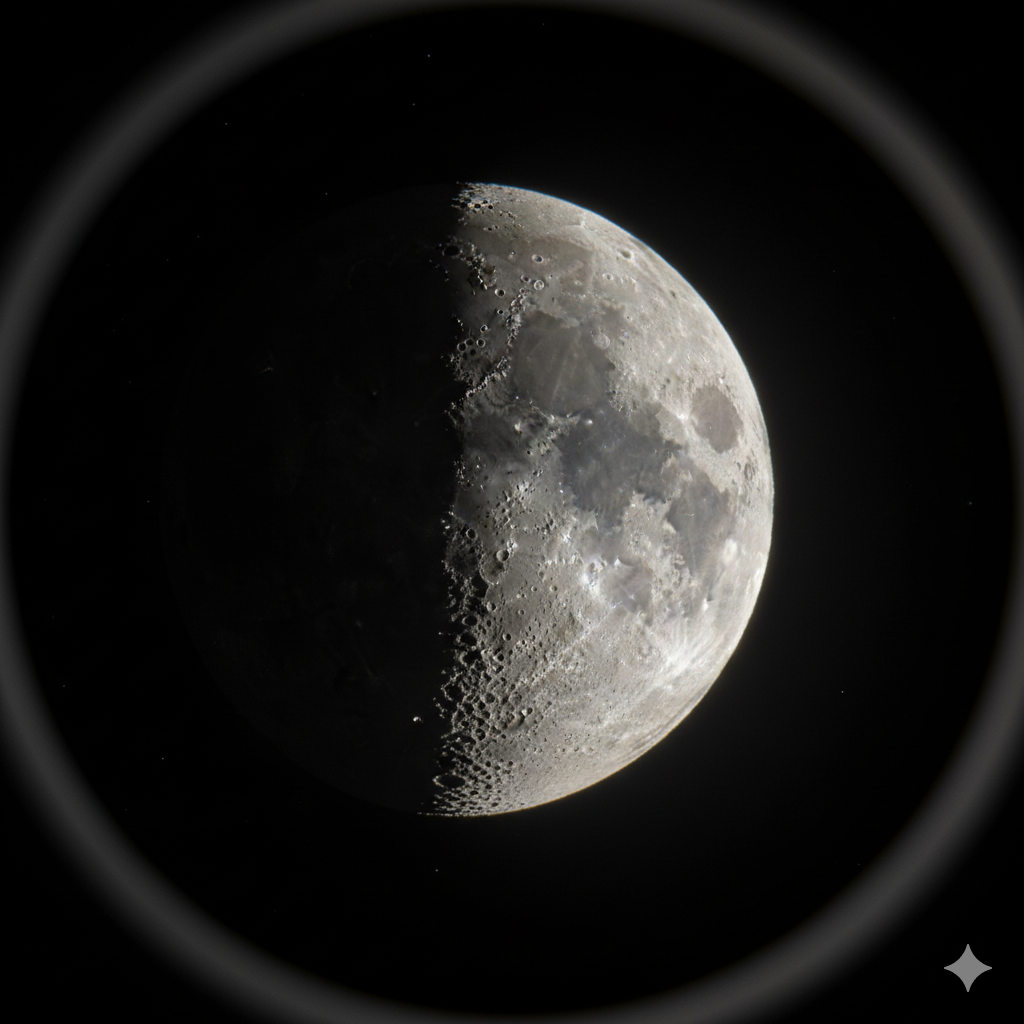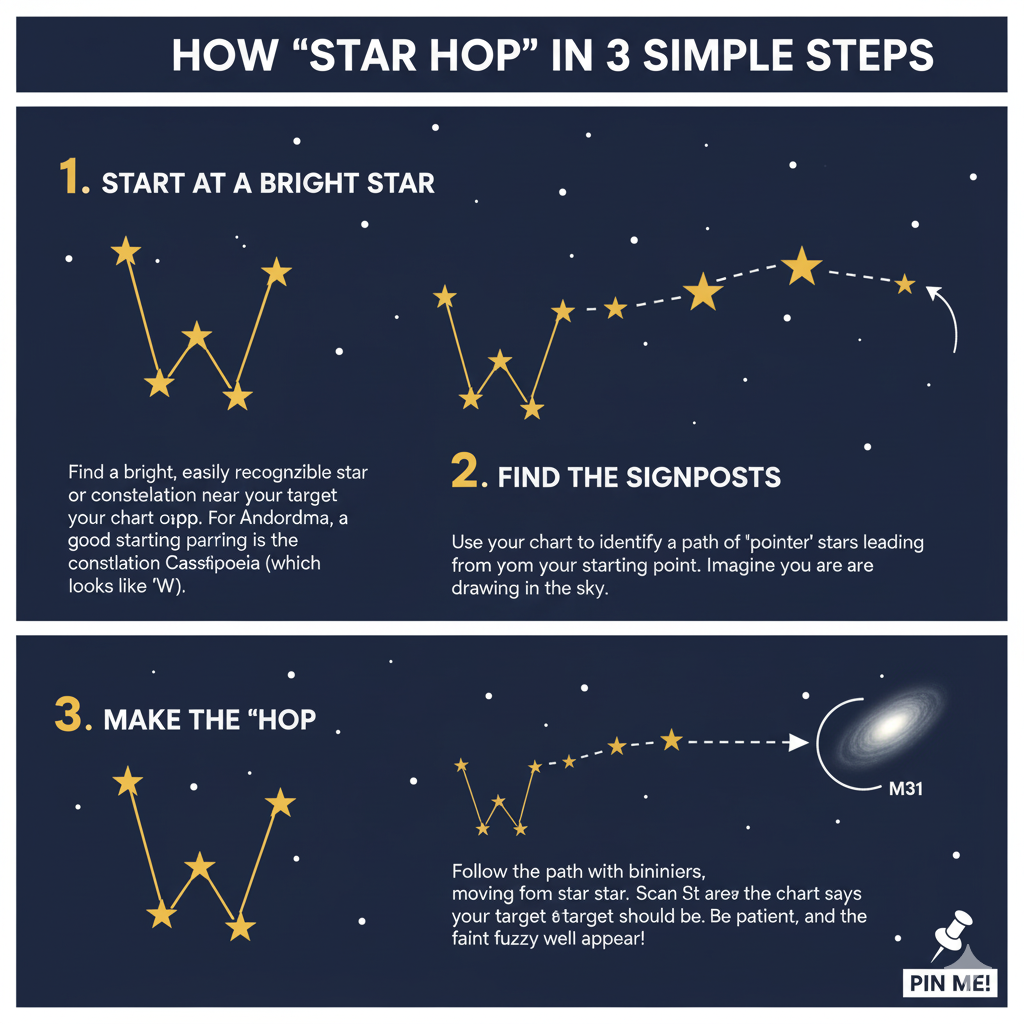Have you ever stood outside on a clear night, looked up at the endless blanket of stars, and felt a profound sense of wonder? A feeling of being part of something vast and beautiful? For most of us, that feeling is quickly followed by a thought: “I wish I knew what I was looking at.” The world of astronomy can seem intimidating, filled with complex charts and expensive, heavy telescopes. But what if I told you that you already have the perfect tool to start exploring the cosmos tonight? That tool is a simple pair of binoculars.
This is A Beginner’s Guide to Stargazing with Binoculars, your personal invitation to a universe of discovery. Forget everything you think you know about amateur astronomy. This is about grab-and-go exploration, about lying back in a comfortable chair and taking a breathtaking tour of our cosmic neighborhood—no complicated setup required.
[Image: A person silhouetted against a rich, starry night sky, looking up through a pair of binoculars with a look of wonder.]
Why Your Binoculars Are a Secret Weapon for Stargazing
Telescopes are incredible, but they often show you a tiny, magnified piece of the sky, like looking at the universe through a straw. Binoculars are different. They are the perfect first step into binocular astronomy for beginners for a few amazing reasons.
- A Wide, Immersive View: Binoculars give you a wide field of view. Instead of seeing one star, you see the star and its entire glittering neighborhood. It feels less like peering through an eyepiece and more like looking out the window of a spaceship.
- Zero Setup, Maximum Portability: There are no mounts to assemble or lenses to align. You just take off the lens caps, point them at the sky, and you’re stargazing. You can take them camping, into your backyard, or even just onto your balcony.
- Incredible Affordability: You might already own a pair! If not, a great pair of stargazing binoculars costs a fraction of the price of even an entry-level telescope, making it the most accessible way to start this fascinating hobby.
Gearing Up: Your Stargazing Essentials Checklist
Getting ready for your first night under the stars is simple. You don’t need a lot of gear, just a few key items to make your experience comfortable and magical.
- [ ] The Right Binoculars: The best all-around choice when you’re choosing binoculars for stargazing are models listed as 7×50 or 10×50. The first number (7x or 10x) is the magnification, and the second number (50) is the size of the main lenses in millimeters. A larger second number means the binoculars gather more light, which is crucial for seeing faint objects in the dark.
- [ ] A Stargazing App: Your smartphone is your personal planetarium. Download one of the best stargazing apps like Stellarium Mobile, SkyView Lite, or Star Walk 2. Just point your phone at the sky, and it will identify constellations, planets, and other celestial objects for you.
- [ ] A Red Flashlight: This is a non-negotiable pro tool! A bright white light from a regular flashlight or your phone screen will ruin your night vision, which can take 20-30 minutes to fully develop. A red light allows you to see your gear and charts while preserving your eyes’ sensitivity to the dark. You can buy a red flashlight or simply tape red cellophane over a regular one.
- [ ] A Comfy Chair & Warm Clothes: You’ll be looking up for a while, so a reclining lawn chair or a thick blanket on the ground is a must. The night sky is beautiful, but it can get chilly quickly, even in summer. Dress in layers!

Ready to explore the cosmos? Pin this checklist to your ‘Hobbies to Try’ board for your first night out!
Your First Night Out: How to See in the Dark
You have your gear, the sky is clear—it’s time to start your adventure! But before you look for targets, you need to prepare your eyes and your space.
- Find Your Dark Spot: Light pollution from city lights washes out the night sky. For the best views, try to get away from direct streetlights. Even a spot in your backyard with the house lights turned off can make a huge difference.
- Let Your Eyes Adapt: This is the most important step! Turn off your phone (or set it to a red-screen mode), avoid all white lights, and just sit in the darkness for at least 20 minutes. You will be absolutely astonished at how many more stars become visible as your pupils dilate and your eyes become sensitive to the faint light of the cosmos.
- Hold ‘Em Steady: Binoculars amplify the tiny shakes from your hands. To get a stable view, try this: sit in a chair, brace your elbows against your chest or on your knees, and gently hold the binoculars up to your eyes. You can also try leaning against a fence or the roof of a car for extra stability.
[Image: A cozy backyard scene at night with a reclining chair, a warm blanket, and a person holding binoculars, looking relaxed and comfortable.]
Your Stargazing Tour: 5 Easiest Celestial Objects to Find with Binoculars (That Aren’t Stars!)
Ready to see what can you see with binoculars at night? Let’s go on a tour of five breathtaking targets that are surprisingly easy to find.
Target 1: The Moon
The Moon is, without a doubt, the single best object to look at first. It’s big, bright, and unbelievably detailed. Don’t look when it’s full—the direct sunlight washes out all the details. Instead, look for it when it’s a crescent or half-moon.
- What You’ll See: You won’t just see a bright circle. You’ll see a rugged, three-dimensional world. Look along the “terminator”—the line between the sunlit and dark parts of the Moon. This is where shadows are longest, making the landscape pop. You’ll clearly see vast craters from ancient impacts, dark, smooth plains called maria (Latin for “seas”), and even mountain ranges. Learning how to see the moon with binoculars is an experience you will never forget.

Target 2: The Pleiades Star Cluster (M45)
Also known as the “Seven Sisters,” this is one of the most beautiful objects in the night sky. To the naked eye, it looks like a tiny, misty cloud or a miniature dipper. But through binoculars, it explodes into a glittering handful of brilliant blue-white diamonds.
- What You’ll See: A breathtaking cluster of dozens of young, hot stars. The view is often more beautiful in binoculars than in a large telescope because you can see the whole sparkling cluster at once.
Target 3: The Orion Nebula (M42)
Have you ever wanted to see the place where stars are born? Look no further than the Orion Nebula. Find the constellation of Orion (famous for its three-star “belt”). Look just below the belt for his “sword,” which appears as three fainter stars in a line.
- What You’ll See: Point your binoculars at the middle star of the sword. You’ll see that it’s not a star at all, but a fuzzy, ghostly cloud of glowing gas. This is a stellar nursery, a vast cloud where new stars are being forged. Seeing this faint glow is seeing creation in action.
Target 4: The Andromeda Galaxy (M31)
This one might give you goosebumps. The Andromeda Galaxy is the closest major galaxy to our own Milky Way, and it’s the most distant object you can easily see with your unaided eye (or binoculars). You are looking at a city of over a trillion stars, whose light has traveled for 2.5 million years to reach your eyes.
- What You’ll See: Don’t expect a brilliant spiral. Look for a faint, elongated, fuzzy patch of light, like a celestial thumbprint on the dark sky. Even as a faint smudge, the sheer scale of what you are witnessing is mind-boggling. Use a stargazing app to find its location in the constellation Andromeda.
Target 5: Jupiter and its Moons
Yes, you can see other worlds! Jupiter is one of the brightest objects in the sky when it’s visible. Through binoculars, you won’t see its cloud bands, but you will see something incredible.
- What You’ll See: You will see Jupiter as a distinctly round, bright disc—not a pinpoint of light like a star. Brace your binoculars very steadily and look closely to either side of the planet. You should be able to spot up to four tiny pinpricks of light in a nearly straight line. These are the Galilean moons: Io, Europa, Ganymede, and Callisto, the same moons Galileo discovered in 1610 with his primitive telescope.
How to ‘Star Hop’ in 3 Simple Steps
Want to find faint objects like the Andromeda Galaxy without a computer? Use this classic astronomer’s trick. It’s like using celestial landmarks.

- Start at a Bright Star: Find a bright, easily recognizable star or constellation near your target using your star chart or app. For Andromeda, a good starting point is the constellation Cassiopeia (which looks like a “W”).
- Find the Signposts: Use your chart to identify a path of “pointer” stars leading from your bright starting point toward your faint target. Imagine you are drawing a line or a shape in the sky.
- Make the “Hop”: Follow the path with your binoculars, moving from one pointer star to the next. Scan the area where the chart says your target should be. Be patient, and the faint fuzzy will appear!
Pro Tips for a Better Viewing Experience
- Check the Moon’s Phase: A bright full moon acts like a giant spotlight, washing out all the faint, deep-sky objects like nebulae and galaxies. The best time for stargazing is during the week leading up to a New Moon.
- Learn a Few Key Constellations: You don’t need to learn all 88, but being able to find the Big Dipper, Orion, and Cassiopeia will give you key landmarks to navigate the sky in any season.
- Patience is Your Greatest Tool: Some nights are better than others. Some targets are harder to find. The joy is in the hunt and the quiet moments of just looking up. Don’t get discouraged. Every moment spent under the stars is time well spent.
Conclusion
The universe can seem distant and complex, but it doesn’t have to be. With a simple pair of binoculars and a little bit of curiosity, you can bridge that distance and connect with the cosmos in a personal and profound way. You can trace the craters on the Moon, witness the birth of stars, and gaze across millions of light-years to another galaxy, all from the comfort of your own backyard. This beginner’s guide to stargazing with binoculars is just the starting point. The real adventure begins when you step outside, take a deep breath, and simply look up.
